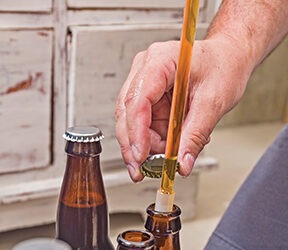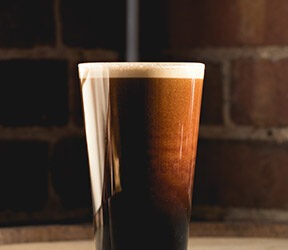Bottled Cask Ale, Dry Hopping & Low-Alpha Bittering: Mr. Wizard
Q
I think that the best beer you can have is real cask ale. But if you only have equipment to bottle your beers, is there anything you can do to make your beers taste a little closer to real cask ale?
Alex Kristensen
Fredericia, Denmark
A
Here in the States, the origins of homebrew trace to England where homebrewing thrived before its rise to a very popular hobby for many beer enthusiasts. Although people have “homebrewed” for as long as history has recorded beer brewing, the hobby we know as homebrewing in the US really began in the early-to-mid 1970s. As these homebrewers refined their craft and became encouraged by the reception to their beers from friends, some departed the ranks of hobby brewer to small commercial brewer and this is largely how the US craft beer scene was born.
What does any of this have to do with cask conditioning? The answer lies in how English brewing practices were applied at home. Most homebrewers brewed ales for two simple reasons. The first was that ales were a good fit because most of the US climate is too warm to ferment lagers at home without special equipment. And the second reason was this is how the English homebrewers did things and ale yeast was the type of yeast that was supplied with most kits.
These homebrewers also followed the directions in the books and manuals printed at the time and did things like “Burtonized” their brewing liquor (known today by some as adding calcium sulfate to water), tossed Irish moss into the kettle at the end of the boil, added hops to their fermenters towards the end of active fermentation and racked their beer from fermenter to bottle for a secondary fermentation in the bottle. Sounds pretty similar to how much homebrew is still made, but the main difference in my opinion is that today’s brewer probably understands more about the “how” and “why” of the methods. Today’s brewer also has access to a wider array of top-quality ingredients.
If the beer described earlier were simply racked into a cask for conditioning and pulled from the cask with a beer engine, “real ale” would be the result. The thing about real ale that intrigues the brewer in me is the basic simplicity of the method. Clarification, aroma modification, carbonation and flavor maturation all occurs in the cask that is later used to hold the beer during dispense. In a “modern homebrewery” outfitted with fancy gear that mirrors some of the practices used by small craft brewers, these operations are often accomplished using three to four different pieces of equipment.
My suggestion in pursuit of your goal is really quite simple. Buy an old homebrew book written in the 1970s or early 1980s, try to forget anything you know about brewing technically perfect lager beers, store any special gear you own for beer clarification in the closet, and choose a recipe for a “simple ale” with a starting gravity somewhere around 1.048–1.052 using what seems to be a modest addition of hops.
The focus will be on ingredients; a balanced flavor profile featuring floor-malted ale malt from England (mild ale malt is a great base-malt choice for many styles) and earthy, British hop varieties are the hallmarks of most cask-conditioned beers. Use Irish moss in the kettle to aid with hot break formation and removal, use an ale strain known to produce some esters and to perhaps leave a hint of diacetyl in the finished beer, add a modest amount of dry hops to the fermenter after primary has completed (about 1⁄4 oz. per gallon/2 grams per liter) and use an isinglass preparation to aid in clarification. The last step is to rack the beer to a bottling bucket, add priming sugar and bottle. Since cask conditioned ales tend to be less carbonated than bottled beers, you may want to target a lower carbonation level (2.2 volumes or 4.5 grams/liter of carbon dioxide). In essence, you want to brew a bottled real ale using the ingredients and techniques commonly used by breweries brewing cask ales.
Q
I am going to dry hop in my dispensing keg for the first time. How long should I leave the hops in the keg?
Rick Dreves
Traverse City, Michigan
A
Dry hopping is a wonderful way to impart hop aroma to beer and is very simple to do. In my experience there are a few things to be mindful of to prevent dry hopping-related problems. The first, and most obvious bit of advice is to use hops that smell good. Really, what’s the good of dry hopping with hops that smell off or have an aromatic note that is unpleasant? I personally do not like hops that have any hint of onion or garlic and simply cannot enjoy beer with those types of hop characters. If there is an aroma type you personally dislike, avoid hops with those properties. Do not rely on canned descriptions of a particular variety, instead you should take a small sample, rub it between your hands and smell the hops before deciding whether you will use them.
The second tip is to minimize the risk of oxidizing your beer by dry hopping towards the tail end of fermentation. Compressed hops, whether in the form of pellets or cones, contain some air. Adding the hops to beer while the yeast is active is a great way to scrub oxygen that is added with the hops. And my last tip is to limit the time that you expose your beer to the hops to about a week. The uptake of hop aromatics in beer happens rather quickly and anything longer than about five days does not do much to increase the hoppiness of the beer. What can happen with prolonged exposure to hop matter is the extraction of flavors that are perceived as grassy and astringent.
You have probably noticed that I did not address your basic question about exposure time to hops in the dispensing keg. This is a method that I do not suggest using because it prevents the brewer from controlling the process unless the beer is consumed over a relatively short time frame. Brewers who add hops to cask-conditioned ales know that when a cask is tapped that it will be consumed over a couple of days. Most homebrewers who keg their beers often plan to enjoy their beer for a couple of weeks. During this time period the beer will begin to pick up some of the grassy qualities from the hops. If you want a nice hoppy beer using a process you can control, consider adding the hops in the fermenter before you rack to your keg. I really believe that the results are better and the end result is more repeatable.
Q
I want to brew a Double IPA, but instead of using hop varieties like Warrior®, Amarillo®, Cascade, Centennial, or Chinook, I want to use Saaz due to the low alpha acid content. I will just use five times more. Everybody I discuss this with insists that I use the high alpha hops for bittering. To me the bitterness of high alpha hops is harsh, and I am hoping that the low alpha Saaz will give the appropriate bitterness without the harshness. Kind of like Stone Brewing co.’s Götterdämmerung that I enjoyed at the last Great American Beer Festival.
Gordon Maness
Arvada, Colorado
A
You are not alone in your belief that certain hop varieties, especially many high alpha varieties, impart a harsh and unpleasant bitterness to beer. Some very large breweries also share this belief and prefer using low-alpha hops for bittering their beers. From an analytical perspective, hops high in the alpha-acid cohumulone are associated with this trait. Many a brewer selects hop varieties partly based on cohumulone content. I happen to be one of those brewers. I am also like your friends in that I do prefer using hops that have pretty decent alpha-acid contents, above 8% for hops added primarily for bittering, because high hop loads associated with using lots of low alpha hops for bittering and aroma can contribute grassy flavors.
Some of my personal favorite varieties to add to wort early in the boil include Perle, Northern Brewer and Nugget. Magnum, Horizon and Simcoe® are some other high-alpha varieties that have low cohumulone content, and appeal to those brewers looking for that particular combination. Mitch Steele from Stone Brewing Co. confirms that Magnum hops were used for bittering the Götterdämmerung and that a huge variety of German hops were used toward the end of the boil, in the whirlpool and in the dry-hop addition.
OK, enough of the textbook stuff about what is “correct” about selecting bittering hops. Innovation does not happen when brewers simply do what is the norm. If American craft brewers listened to the jabs from Europe and Britain about “catty” hop varieties being unfit for anything other than adding bitterness to beer, then Cascade hops would have never been used as an aroma variety. Today, Cascade is timid compared to some of the newer varieties bred to produce intense aromas considered wholly inappropriate not long ago. And German hop growers are even planting US aroma varieties that no traditional lager brewer would ever consider using.
As the saying goes, nothing ventured, nothing gained. I am sure that the brewers at Stone Brewing Co. who developed Götterdämmerung would encourage you to simply give your idea a try. The worst that can happen is that you end up with a bad batch of beer, and if things go the way you envision then you end up with something that makes you happy. Either way you will learn something that will likely make you a better brewer. Prost!
Q
After fermenting my beers I have always “cold crashed” the carboy or bucket in my temperature-controlled chest freezer or outdoors (during the cooler months) for a few days before bottling. This gives me a nice, compact yeast cake and seems to clear the beer very well, especially if I add gelatin. However, when I do this, my airlock works in reverse and seems to suck in plenty of air. I have become concerned about this method introducing oxygen into my finished beer. Do you think this is something I should be worried about?
Adam Sickmiller
Cincinnati, Ohio
A
This is a fairly common question and is clearly a concern to many homebrewers. Although I have answered a similar question before, I will give a slightly different spin on this topic. The general rule is that there is only one place in the brewing process where oxygen should be introduced, and that is during wort aeration. After this point, beer oxidation can result from air pick-up. The good news about homebrewing is that yeast is normally present and even yeast that is not actively fermenting absorbs oxygen and helps to protect beer from oxidation. This is why bottle conditioned beers are known to have better shelf life than filtered beer, especially when air pick-up during filling is high. The flow of air into your fermenter certainly would not make my top 10 list of problems homebrewers should worry about.
What does concern me a bit more is the tendency of some airlocks to suck liquid into the fermenter when they operate in reverse. Even if you use an airlock design that does not allow liquid to be sucked into your fermenter when cooled, the air that is sucked could potentially contaminate your beer. And adding alcohol to the airlock as an air sterilizer is not very effective since gas flows through in large bubbles and has a very short contact time. I suggest using cotton batting to filter air as it flows into the fermenter headspace upon chilling, and then replacing the airlock after the beer has cooled.
If you are really concerned about the air pick-up, consider racking into a keg and applying top pressure prior to crashing. Or you can introduce a slow flow of carbon dioxide into the headspace of a glass fermenter that has a cotton plug or airlock with a second hole to provide a slow flow of cover gas during cooling. This latter method will be difficult to control without a special regulator and is really a method that I would only use for experimental purposes.



